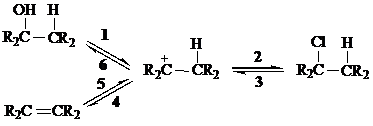
Concept explainers
A Mechanistic Preview of Addition Reactions
The following flow chart connects three of the reactions we have discussed that involve carbocation intermediates. Each arrow may represent more than one elementary step in a mechanism.

Arrows
The reaction indicated by arrow
What term best describes the relationship between analkene and a carbocation?
A. Isomers
B. Resonance contributors
C. Alkene is conjugate acid of carbocation
D. Alkene is conjugate base of carbocation
Want to see the full answer?
Check out a sample textbook solution
Chapter 7 Solutions
ORGANIC CHEMISTRY 2 YEAR CONNECT ACCES
- Which of the following statements is TRUE regarding the reaction below? Options: The IR spectrum of the major organic product will show a broad absorption between 3000-3500 cm-1. The mass spectrum of the major organic product will show an M+2 peak in the molecular ion region. The reaction should proceed without carbocation rearrangement. The alkene is the electrophile and water is the nucleophile in the first step. HSO4- is the dominant nucleophile in the second step.arrow_forwardShow stereo chemistry and possible outcomes and the steps for the reaction.arrow_forwardPlease give major organic products along with mechanism. Please also identify what type of reaction it is (SN1, SN2, E1, E2)arrow_forward
- Give a detailed reaction mechanism for the reaction expected to occur when 2-bromo-2-methylpentane is heated with sodium methoxide. Draw clear structural formulas of all relevant species and use curved arrows to represent electron flow. Also indicate which step is likely to be rate-determining. The answer you sent before will be used for this question.arrow_forward1. i.What are the various ways by which alkenes may be synthesized? ii. Give two examples each of Unsymmetrical alkenes and reagents. iii. Give two examples of reactions of alkenes that result in Anti-Markonikov’s addition productsarrow_forwardConsider the following statement in reference to SN1, SN2, E1, and E2 reactions of haloalkanes. To which mechanism(s), if any, does the statement apply? Involves a carbocation intermediatearrow_forward
- iii) 2-Bromo-2-cyclopropylpropane will undergo an SN1 reaction called solvolysis in methanol to give several products, two of which are shown below. Use curly arrows to show how the formation of these two products occurs mechanistically.arrow_forwardPlease answer this NEATLY, COMPLETELY, and CORRECTLY for an UPVOTE. Which of the following reactions will involve rearrangement? A) Acid-catalyzed addition of H2O to an alkene. B) E2 elimination. C) Free radical halogenation of alkanes. D) Addition of Cl2 to an alkene. E) None of the choices is correct.arrow_forwardSecondary alcohols are often dehydrated in an E2 reaction to give an alkene. Elimination follows Zaitsev's rule to give the more substituted alkene as the major product. Since the reaction occurs via an E2 mechanism, there is no risk of rearrangement of the carbon skeleton as could possibly occur if the elimination occurred via an E1 mechanism with a carbocation intermediate.Draw curved arrows to show the movement of electrons in this step of the mechanism.arrow_forward
- please answer part two (Please answer "What is BP of the solvent, and the authors state... why is that important"). thank you "The 3-Sulfolene is the prime molecule used for synthesis for the 1,3-butadiene molecule. The mechanism involves breaking of two C-S bonds in 3-sulfolene to generate 1,3-butadiene in the presence of heat. The reaction can be shown as below: This reaction is a type of pericyclic reaction that involves breaking and making of bonds in a single step and hence there will be no intermediate formed. The solvent used here is water." https://www.bartleby.com/questions-and-answers/3-sulfolene-a-butadiene-source-for-a-diels-alde-synthesis.-please-be-prepared-to-take-a-quiz-on-this/8bf8358d-dbdf-46f9-97db-6f744d66c0cdarrow_forwardConsider the following statement in reference to SN1, SN2, E1, and E2 reactions of haloalkanes. To which mechanism(s), if any, does the statement apply? Order of reactivity of haloalkanes is methyl . 1° > 2° > 3°.arrow_forwardPart 1 regards the images.Part 2: Identify the 4 unique common elementary steps in the above mechanism. (Electrophilic addition, Carbocation rearrangement, Bimolecular nucleophilic substitution (SN2), Nucleophilic addition, Nucleophile elimination, Bimolecular elimination (E2), Coordination, Proton transfer, Electrophile elimination, Heterolysis).Part 3: Fill in the blank: Both E1 and E2 produce the ___ alkene.arrow_forward
 Organic ChemistryChemistryISBN:9781305580350Author:William H. Brown, Brent L. Iverson, Eric Anslyn, Christopher S. FootePublisher:Cengage Learning
Organic ChemistryChemistryISBN:9781305580350Author:William H. Brown, Brent L. Iverson, Eric Anslyn, Christopher S. FootePublisher:Cengage Learning Organic Chemistry: A Guided InquiryChemistryISBN:9780618974122Author:Andrei StraumanisPublisher:Cengage Learning
Organic Chemistry: A Guided InquiryChemistryISBN:9780618974122Author:Andrei StraumanisPublisher:Cengage Learning

